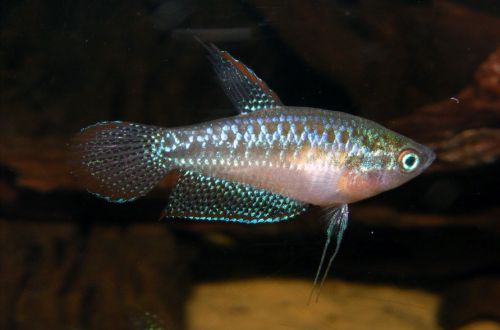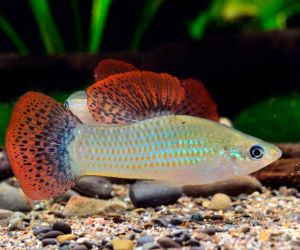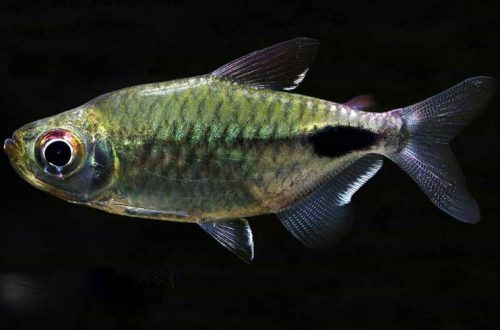
Dwarf Gourami
Dwarf gourami or Pumila, scientific name Trichopsis pumila, belongs to the Osphronemidae family. A popular aquarium fish with an interesting coloration, easy to keep and breed. Small size and timid disposition significantly limit the number of possible neighbors, therefore, it is often kept in a species aquarium.

Contents
Habitat
It comes from Southeast Asia, is widely distributed in most of Vietnam, Cambodia, Thailand and Peninsular Malaysia. Inhabits swampy shallow ponds with stagnant water, flooded rice fields, canals with very dense vegetation.
Brief information:
- The volume of the aquarium – from 40 liters.
- Temperature – 22-28°C
- Value pH — 5.0–7.5
- Water hardness – soft (1-12 dGH)
- Substrate type – any soft
- Lighting – subdued
- Brackish water – no
- Water movement – little or no
- The size of the fish is up to 4 cm.
- Food – any food
- Temperament – peaceful
- Content in a couple or small group
Description
Adult individuals reach a length of up to 4 cm. The color is light brown with an intense blue sheen. Two dark stripes stretch along the body. The fins are translucent with a pattern of red and blue dots. Sexual dimorphism is weakly expressed, males differ from females in magnifying fins and color intensity.
Food
In nature, they feed on small insects and invertebrates, in home aquariums it is advisable to serve live food (daphnia, brine shrimp, bloodworms), or use special products intended for representatives of the Gourami species from well-known and trusted manufacturers.
It is worth remembering that the quality and variety of food directly affect the health of the fish and their color.
Maintenance and care, arrangement of the aquarium
A tank with a volume of 40 liters is suitable for one pair or a small group of fish. The design uses a soft substrate and dense thickets of rooted plants located along the side walls of the aquarium. The presence of shelters is mandatory, usually they install various snags, ceramic pots or hollow tubes and other decorative objects in the form of sunken ships, castles, etc.
A filter with peat-based filter material is used to mimic the water conditions of a natural habitat, and the hydrochemistry is set to a slightly acidic pH and a low hardness level (dGH). You can enhance the effect with the help of fallen leaves, which are placed on the bottom, in the process of decomposition, they saturate the water with tannins and slightly tint it in a light brown color.
The collected tree leaves are pre-dried and then soaked for several days, for example, in a plate, so that they are soaked and begin to sink. Leaves are renewed for new ones every two weeks.
All labyrinth fish come from waters with low levels of dissolved oxygen, including the Dwarf Gourami, so they have developed an additional mechanism for obtaining it directly from the air by swallowing bubbles from the surface. To avoid temperature contrast (water/air), the aquarium should be equipped with a lid, if it is not included in the kit, due to which a warm air layer will remain above the surface.
Behavior and Compatibility
Peaceful and very timid species, not recommended for the general aquarium, since any even small, but very active fish can intimidate the Dwarf Gourami. Mixed keeping with species of similar size and temperament, such as Dwarf Rasbora and Firefly Rasbora, among others, is allowed.
Breeding / breeding
During the mating season, males build a nest of bubbles under broad leaves, under dense floating vegetation or in a cave-like shelter on the bottom – the same ceramic pots or hollow tubes used in decoration. During the construction process, the male is very harsh towards the female and does not let her near the nest until it is ready.
Spawning is accompanied by a kind of “embrace”, when the fish, the word, wrap around each other. At the point of climax, milt and a few eggs are released and then placed in the nest. This is repeated several times until all the eggs are released. The female then swims away, leaving the male to protect and care for future offspring.
The fry appear in 24–48 hours and remain in the nest for another 3–4 days, all this time the male carefully picks up those who accidentally fell out / swam out of it. After the fry begin to swim freely, the male will lose interest in them. Adult fish do not suffer from cannibalism and usually do not eat their offspring. However, this does not apply to other aquarium neighbors and it is advisable to transfer the juveniles to a separate tank with identical water conditions. Feed with specialized food for aquarium fish fry.
Fish diseases
The main cause of most diseases is unsuitable living conditions and poor-quality food. If the first symptoms are detected, you should check the water parameters and the presence of high concentrations of hazardous substances (ammonia, nitrites, nitrates, etc.), if necessary, bring the indicators back to normal and only then proceed with treatment. Read more about symptoms and treatments in the Aquarium Fish Diseases section.





